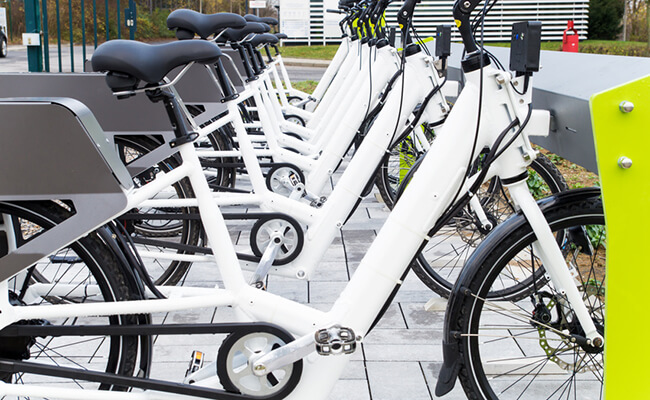Sometimes, a major innovation will start at the top of a market and work down—think of the Tesla electric sports car. Other times, as innovation theorist Clayton Christensen noted 20 years ago in The Innovator’s Dilemma, innovations bubble up from the bottom, beginning with a product that has limited functionality and seems at first like little more than a toy.
That second uphill path has been the trajectory of the electric bicycle or e-bike, which over the past 20 years has become an important mode of personal transportation in China and is now beginning to make inroads in the rest of the world. Even as the world’s automakers try to retool themselves for an electric future, some 200 million Chinese bikers already get to and from work on highly efficient electric vehicles that sell for as little as $300, with another five million joining the stream every year.
Of course, electric cars still have many capabilities and advantages that e-bikes don’t, but in a world where more and more people live in dense, urban landscapes, could it be that an important part of the future of electric transportation isn’t being designed on the whiteboards of Detroit, Stuttgart, or Nagoya but is already bouncing down Chinese streets?
Although the automotive companies continue to focus on achieving the engineering feat of extending the range of electric cars to roughly the same as a tank of gas gives, e-bikes have steered around the problem altogether by focusing primarily on short trips. Car company ads often picture happy drivers hurtling down the open road, but over half of all trips in the US are under three miles, according to Christopher Cherry, Professor of Civil and Environmental Engineering at the University of Tennessee, Knoxville, and an authority on e-bikes.
Indeed, some analysts believe that e-bikes will soon disrupt the conventional motorcycle market. “Electric bikes are rapidly evolving to meet 80% of the use cases of the bottom end of the motorcycle market,” writes cleantech consultant Michael Barnard. “The trend is clear. The next generation of motorcycle manufacturers will be the current generation of electric bicycle manufacturers unless the majors get their houses in order,” he predicts.
The first push
Inventors first tinkered with electric bicycles in Europe in the 1890s, but the modern era of electrics began only a century later, around 2004, in China.
No one knows quite why e-bike popularity exploded in China when it did, according to Cherry. However, he says, a number of factors contributed to the boom. Two of the most important: China already had a lot of protected bicycle lanes, and the government placed tight strict legal constraints on gasoline-powered motorcycles.
In addition, Ed Benjamin, Senior Managing Director of eCycleElectric, a Ft. Meyers, Florida-based consultancy specializing in the e-bike industry, says that the Chinese government made e-bikes cheaper to register than other kinds of vehicles, funded research into e-bikes, and supported companies that wanted to enter the e-bike business.
E-bikes also have three important structural advantages over other forms of motorized transport, according to e-biking advocates. First, they have the maneuverability of conventional bicycles. Second, they are cheap to run: 20 cents’ worth of electricity can keep an e-bike humming along for 100 km. Third, while most e-bikes have top speeds under 30 kmh, it’s the alternative that counts, and average speeds of buses and cars in traffic may not be significantly different, particularly after factoring in the ease of parking the e-bike offers. One extensive Australian study found that for commutes of under 10 km, the e-bike’s performance was not significantly worse in terms of travel time, speed, payload capacity, or door-to-door flexibility than that of cars or buses.
E-bikes are unevenly distributed
The cyberpunk writer William Gibson famously quipped that the future is already here – it’s just unevenly distributed. Whether e-bikes are the future remains to be seen, but they are certainly unevenly distributed at the moment.
Outside China, adoption has been uneven. In most Asian countries, outside of Japan, dedicated bicycle lanes are scarce, and people have preferred to buy more powerful scooters and motorcycles. In the United States, too, one of the world’s largest bicycle markets, e-bike sales are low but growing rapidly. In 2017, eCycleElectric estimated that 263,000 e-bikes were sold in the US , and sales continue to rise about 10-15% every year. However, Cherry argues that until more dedicated bike lanes are built, interest will continue to be relatively limited.
Europe, by contrast, has been much more receptive, at least in more bicycle-focused countries, such as the Netherlands, Denmark, and Germany. In the Netherlands, where 25% of all trips are made by bicycle (and bicycles outnumber people), e-bikes have been adopted with enthusiasm. Of the country’s 23 million bicycles, two million are e-bikes, according to one recent Dutch government survey. E-bikes are particularly popular with elderly Dutch riders: nearly half of the 400 million kilometers traveled by e-bike are ridden by people 65 or over, according to government estimates.
The survey also noted that 40% of Dutch e-bike owners reported using their cars less after they bought an e-bike and 30% took fewer train, tram, and bus trips. In a review article that summarizes a variety of studies on e-biking in a number of different countries, Cherry and Elliot Fishman, Director of Transport Innovation at the Institute for Sensible Transportation in Melbourne, Australia, also noted a similar phenomenon elsewhere. Several studies have shown that people who own e-bikes often start using them for transportation instead of other motored travel options.
The Killer App
“E-bike riders ride more and farther than they did as [conventional] cyclists,” Cherry said in a telephone interview. “They substitute car trips at a higher rate than you would expect. It changes behavior in a meaningful way.”
However, while they are cheaper and reportedly more invigorating than many other forms of transportation, the “killer app” of the e-bike for society may be its ultra-low environmental impact. Cherry and Fishman note that scientists have found that most e-bikes consume less than 2 kWh/100 km, about one-tenth the energy consumption of a small electric car and around 40 times less carbon dioxide expended by fossil-fueled electrical power plants than a standard car traveling the same distance.
“It’s an amazingly low-cost, low-energy solution,” said Cherry.



















